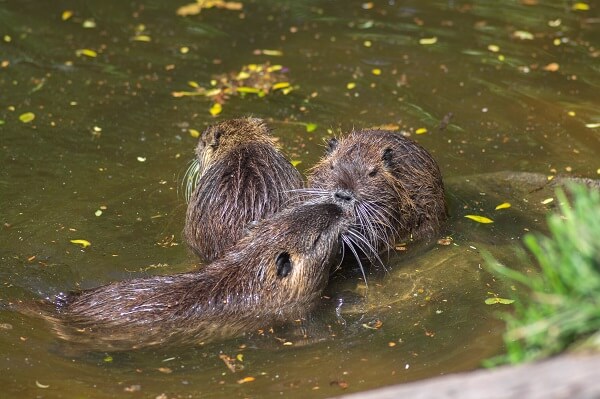
The nutria rat (Myocastor coypus), also known as the coypu or swamp rat, is not really a rat but is a large rodent that makes its home close to freshwater. Native to South America, nutria rats are now found across North America, where they were introduced through the fur trade. They have established populations across the world and are considered an invasive species, as they disrupt the natural ecosystem. Nutria rats are relatively large rodents that are similar in size to a raccoon. The nutrias fur is made up of long, shaggy hair on the outside that is yellow or brown. Their undercoat is much more beautiful, and they are often trapped or farmed for their undercoats, which are used by the fashion industry. Aside from their scruffy outer coat, nutria rats also have long tails and large, orange front teeth. They are mostly aquatic and strong swimmers with webbed hind feet. These rodents build their homes close to river banks or near other freshwater areas such as ponds, lakes and wetlands. They are also strong diggers and make their homes underground. These rats eat mostly aquatic plants and vegetation but are also known to eat some invertebrates such as snails or mussels. Nutria rats may be mostly herbivorous, but the amount that they eat can do a lot of damage to an ecosystem. These giant rats can consume up to a quarter of their body weight in plant material every day! These rodents are fast reproducers, reaching sexual maturity at just five months of age. The rats can breed multiple times a year, producing between five and seven young in each litter. One female can have up to 200 babies in her lifetime! This fast rate of reproduction means that populations can snowball, which is what makes them such efficient invasive species. Escapees from fur farms can establish new populations in non-native areas, causing damage to vegetation and destroying wetlands habitats. They also cause damages to flood control systems and spread diseases. Nutria rats are prey for several different species, including bald eagles, hawks, cottonmouth snakes, garfish, dogs, turtles, and alligators. However, nutria rats are nocturnal, which can make it difficult for diurnal species to hunt them. During the day, they will hide out in heir burrows to avoid predators. Humans also hunt nutria rats for their fur and, sometimes, their meat. These large rodents are considered pests and bad for the non-native environment which they have invaded. However, as such successful invasive species, they must have a number of adaptations that are excellent examples of biological concepts for us to explore. Let’s take a closer look. Nutria rats spend a lot of their time in and under the water, swimming and foraging for food. They have several adaptations that enable them to live this semi-aquatic lifestyle. One of the most interesting adaptations that these rats have is the presence of valves in their nostrils and mouth. When the rats are diving and submerged underwater, these valves can close, preventing water from getting inside these orifices. They can also hold their breath for up to five minutes! Nutria rats are successful invasive species, establishing several populations across North America and Europe. They were introduced to these areas by humans who had trapped and transported them to establish farms or breeding colonies for use in the fur trade. Invasive species are animals that are not naturally found in an area and cause considerable damage to the ecosystem. Nutria rats have all the characteristics of an invasive species. They are generalists – feeding on a wide range of vegetation and consuming all of the plants, from leaves to roots and shoots. These rodents are relatively long-lived and have a high reproduction rate. They also have few predators. Although several animals will eat nutria rats if they come across them, their nocturnal lifestyle helps them to avoid predators that hunt in the day. Nutria rats cause considerable damage to non-native ecosystems. Not only are they destroying riverine and wetland areas, but they are also known to damage agricultural crops such as rice and sugarcane in certain states. They can cause so much damage that the Department of Wildlife and Fisheries in Louisiana currently allows anyone with a hunting license to kill up to five of these critters a day! Which demonstrates just how much of a problem they are. Humans have caused the spread of several invasive species worldwide! For instance, in the Great Lakes, humans introduced zebra mussels, which have spread like wildfire and caused a reduction in the population of native pearly mussels. Other examples of invasive species in the United States are Japanese knotweed, the grass or Asian carp, and lionfish. Nutria rats spend a lot of time in the water, and many of their adaptations make them suited for their semi-aquatic lifestyle. One of the most exciting adaptations that these rodents have is one that allows them to feed their young while floating in the water. Like all mammals, females have mammary glands that enable them to produce milk to feed their young. Nutria rats have four pairs of mammary glands that are located on the side of the body, rather than on the belly. The young can then feed with their nose above the water’s surface while the mother is floating.
Kingdom
Animalia
Phylum
Chordata
Class
Mammalia
Order
Rodentia
Family
Myocastoridae
Genus
Myocastor
Species
Myocastor coypus
Niche
Aquatic omnivore
Length
17 and 25 inches long (43 to 64 centimeters) plus tail
Weight
15 and 22 pounds (7 to 10 kilograms)
Lifespan
8 – 10 years
Social Structure
Social, live in large colonies
Status
Least concern
Preferred Habitat
Freshwater regions
Average Litter Size
5 – 7 young
Main food item
Plants and roots
Main predators
Eagles, hawks, snakes, alligators, and dogs
The Basics


Interesting Insights from the Nutria Rat!
Nose and Mouth Valves
Succesful Invasive Species

Mammary Glands
